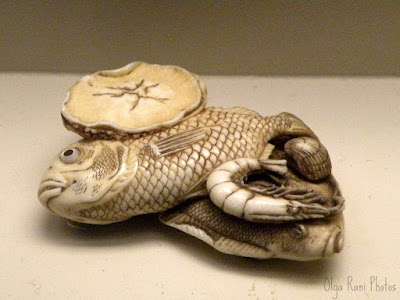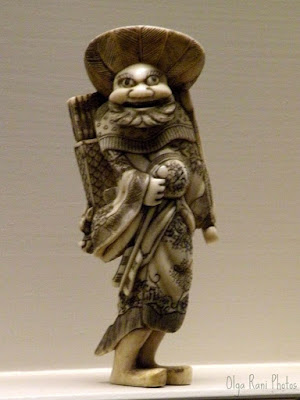Originally netsuke was invented with purely domestic purposes: a Japanese traditional kimono costume did not have pockets but men who wore them needed a place to store their personal belongings, such as pipes, tobacco, money, seals, or medicines. These little things were put in small bags or boxes and hung by cords from a wide obi sash. So that the bag might not slide off, a counterweight was hung at the other end of the cord. And to match the elegance of the dress, this fastener had to be a neat little piece of art. So there came netsuke. Charms, leather wallets, sake field bowls were fastened with the help of netsuke, and in the 18th century, when tobacco became very popular in Japan netsuke were used to attach pouch.
There were two main requirements for netsuke: it had to be strong to be able to hold an object attached to the belt, and it had to be of a nice interesting design. Netsuke were made in the form of gods and demons, historical figures, animals and birds, plants, people of different professions. By netsuke one could determine the social status of its owner, find out what he enjoys. For example, gamblers liked the netsuke in the shape of a snake or a skull, which was to bring them good luck, the believers - the famous Buddhist figures, lovers of theater - netsuke depicting a mask. Netsuke were carved from wood, bamboo, ivory and walrus ivory, tortoise shell, deer or buffalo horns, wild boar tusks. Also metals, porcelain, agate, amber, glass, jade were used.
For a long time netsuke was only part of the ensemble, supplementing the kimono. But with European costume with its dozen pockets coming in the Japanese everyday life netsuke became a form of decorative art. Now Japanese netsuke are made for collectors mostly. There is even an "International Society for collectors of netsuke", bringing together the collectors of the thirty countries in Asia, America and Europe.
The cost of modern netsuke figurines ranges from a few hundred dollars to several thousand. Antique examples are valued much more expensive. For example, at London's Sotheby's auction the netsuke by the Japanese master Kaigyokudo Masatsugu was estimated at $ 213,000.
Photos: netsuke from the collection of the British museum and the Victoria and Albert musem.














Wow, these are really beautiful netsuke! Do you happen to remember the name of the Russian film?
ReplyDeleteI would guess it was "Kanikuly Krosha" from 1979.
ReplyDelete